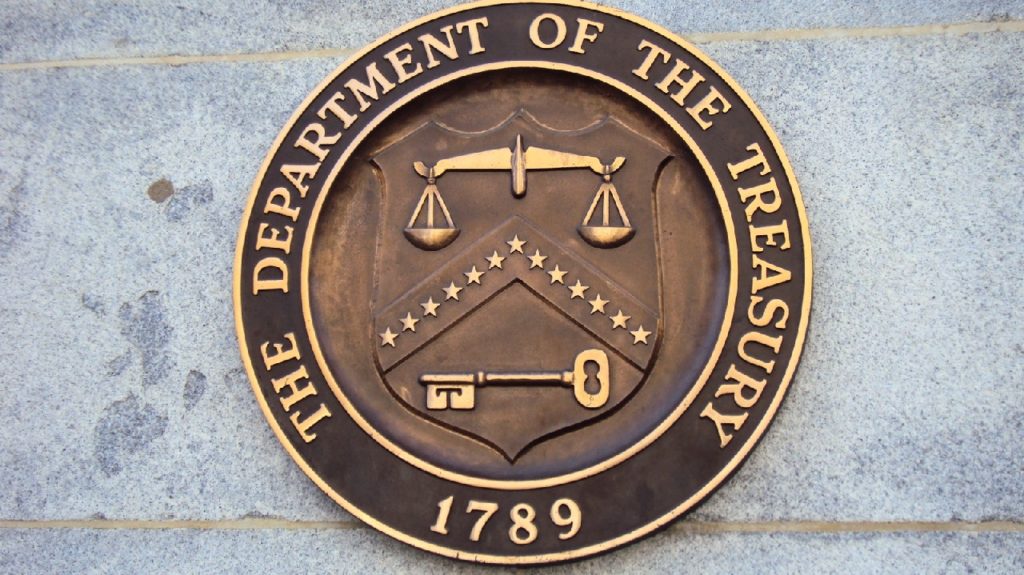US Treasury Department Set to Unleash Another Tidal Wave of Inflation
The Federal Reserve increased the money supply at a record rate in 2020. And a move recently announced by the US Treasury Department will mean even more money flooding into the marketplace. In other words, another tidal wave of inflation.
The Treasury plans on drawing down the $1.6 trillion balance in its Treasury General Account (TGA) at the Federal Reserve. According to the announcement, the Treasury plans to cut the accounts balance in half by April and draw it down to $500 billion by the end of June as the Biden administration ramps up spending even more in the coming month.
The TGA holds funds coming into the federal government from both taxes and the sale of Treasury bonds. The amount of cash in that account has skyrocketed in recent months as the Treasury has borrowed to pay for the massive stimulus spending authorized by Congress. The balance in the TGA is four times bigger than it was a year ago. According to Reuters, the balance has rarely exceeded $400 billion and before 2016, it was never above $250 billion.
The account balance is so high now because the government has borrowed, but the accumulated money hasn’t been spent yet.
That’s about to change.
When individuals or businesses receive a government check, they deposit the money in their bank account. For illustrative purposes, let’s say somebody deposits their government check at Bank of America. BoA then presents the check to the Fed. The Fed debits the US government’s TGA account and credits Bank of America’s account at the Fed. This increases BoA’s reserve balance. That means Bank of America has more money to lend or invest in financial markets.
Credit Suisse called the planned drawdown of the Treasury’s Fed account as a “tsunami” of cash into depositary bank reserves. And at least some of this money is going to find its way into the marketplace. That means more asset inflation. In other words, the Treasury is about the blow the asset bubbles even bigger.
The drawdown in the TGA also means the US Treasury will be selling fewer Treasury bonds. Banks often use these as collateral for repo borrowing and hedging derivative trades. A JPMorgan official told Reuters this will increase liquidity even further.
Fewer bills mean more cash looking for a home in liquidity land. US money market and short term debt market participants are knee-deep in liquidity.”

In a nutshell, we’re talking about even more inflation pumped into an already inflationary environment.
According to the Reuters‘ report, US banks are already awash with cash.
The Fed is buying securities worth $120 billion from them each month, aggregate household savings are $1 trillion above pre-COVID levels, and money-market funds are brimming, with assets $700 billion above pre-pandemic levels. In short, the M2 money supply aggregate is growing at an annual 26% rate.
Analysts with CitiBank told Reuters the TGA rundown will effectively triple the amount of bank reserves created by QE every month.
So what?
Short-term yields will likely be pushed even lower, even as long-term yields are rising. In fact, many analysts expect the Treasury’s maneuvering will take real short-term interest rates negative. As Reuters put it, “Negative yields could see cash flee money market funds for other assets – longer-dated bonds, equities, commodities and so on, further inflating bubble-like markets.”
In other words, this will continue to pump up the stock market bubble, the real estate bubble, the bond bubble, and other asset bubbles. This is all well and good until the bubbles pop – and at some point, they will.
The massive increase in liquidity will also put further pressure on a weakening dollar.
In effect, the Treasury Department is set to unleash even more inflationary pressure. As we’ve pointed out, inflation is a tax that lowers our standard of living.
As Peter Schiff has pointed out, the Fed can’t fight inflation. In fact, it’s not even going to try. The strategy seems to be to tell us price increases aren’t really inflation.
The economy can’t survive higher interest rates. There is too much debt. The Fed will have to step in and buy more bonds to hold rates down. And that means more money printing — more inflation. And if rising rates start to spook the stock market that will really spell trouble for the central bank. Eventually, the market will roll over. And how will the Fed respond? It will print even more money. As Schiff has said, this is all bullish for gold and silver.
At some point — I don’t know when – but at some point, and I think it’s not too far off, the market is going to react to a falling bond market by buying gold, not dumping it.”





 Since Nayib Bukele became president of El Salvador, El Salvador has been in American media and global political discussion more than ever. While much of the attention focuses on Bukele’s mass incarceration of gang members and a decline in homicide of over 70%, Bukele has also drawn attention to his favoritism towards Bitcoin and how he […]
Since Nayib Bukele became president of El Salvador, El Salvador has been in American media and global political discussion more than ever. While much of the attention focuses on Bukele’s mass incarceration of gang members and a decline in homicide of over 70%, Bukele has also drawn attention to his favoritism towards Bitcoin and how he […] With gold hitting yet another awe-inspiring all-time high in the wake of Powell’s remarks reassuring markets (more or less) to expect rate cuts in 2024, a few analysts are pointing out risk factors for a correction — so is there really still room to run?
With gold hitting yet another awe-inspiring all-time high in the wake of Powell’s remarks reassuring markets (more or less) to expect rate cuts in 2024, a few analysts are pointing out risk factors for a correction — so is there really still room to run? Gold hit a new all-time nominal high, surpassing the previous record set in December of the previous year. The precious metal’s price reached approximately $2,140, indicating a robust and continuing interest in gold as a safe-haven asset, despite a rather peculiar lack of fanfare from the media and retail investors. This latest peak in gold […]
Gold hit a new all-time nominal high, surpassing the previous record set in December of the previous year. The precious metal’s price reached approximately $2,140, indicating a robust and continuing interest in gold as a safe-haven asset, despite a rather peculiar lack of fanfare from the media and retail investors. This latest peak in gold […] The gold price has been surging, with unprecedented central bank demand gobbling up supply. It has been a force to behold — especially as US monetary policy has been relatively tight since 2022, and 10-year Treasury yields have rocketed up, which generally puts firm downward pressure on gold against USD.
The gold price has been surging, with unprecedented central bank demand gobbling up supply. It has been a force to behold — especially as US monetary policy has been relatively tight since 2022, and 10-year Treasury yields have rocketed up, which generally puts firm downward pressure on gold against USD.  Total gold demand hit an all-time high in 2023, according to a recent report released by the World Gold Council. Last week, the World Gold Council (WGC) released its Gold Demand Trends report, which tracks developments in the demand for and use of gold around the world. Excluding over-the-counter (OTC) trade, 2023 gold demand fell slightly from 2022 […]
Total gold demand hit an all-time high in 2023, according to a recent report released by the World Gold Council. Last week, the World Gold Council (WGC) released its Gold Demand Trends report, which tracks developments in the demand for and use of gold around the world. Excluding over-the-counter (OTC) trade, 2023 gold demand fell slightly from 2022 […]